

Actually I think even the greatest OS/2 aficionados would have hard
time telling whether this is OS/2 2.0 or 2.1. So you'll just have to take
my word for it. Another thing you can't tell from the above screenshot
is the fact that it's actually OS/2 2.1 Special Edition, better known as
OS/2 for Windows, released in October 1993.
That got me past the first hurdle. The second one followed very shortly. As I mentioned, I have the CD-ROM version. I really wasn't going to create 20 floppies although in retrospect, it would have saved me a lot of time. I actually have two CD-ROM drives: new IDE DVD-ROM and an old SCSI CD-ROM attached to an Adaptec 2940 PCI controller. It's really too bad that OS/2 2.1 had drivers for neither - I believe both IDE CD-ROMs and Adaptec 2940s appeared just a short while after OS/2 2.1. I tried the Adaptec driver from Warp but it wouldn't even load under 2.1, apparently due to missing PCI support. So I had a nice shiny CD-ROM but couldn't get at the data it contained.
Fortunately, I have more tricks up my sleeve. I used to have similar problems long long ago with OS/2 Warp and an old Mitsumi double-speed CD-ROM that had its own proprietary controller. Because back then I could access my CD-ROM from DOS, I learned that it is possible to copy the contents of CD-ROM onto harddrive and install from there (the file OS2SE20.SRC in root directory tells the installer where to look). So I did that.
I went through first phase of the installation process without problems. But then the partially installed OS/2 wouldn't reboot and locked up right after Boot Manager. This was fixed by reenabling L1 and L2 CPU cache - don't ask me why. Unfortunately that only led to the biggest hurdle of them all. I still couldn't boot and was getting errors about missing VIOTBL.DCP, DOSCALL1.DLL and more. I knew this had to mean something else because all the files were present. I tried many different things until I had the bright idea to edit the CONFIG.SYS to boot to CMD.EXE instead of the installation shell. When I saw that the command prompt was sitting on drive L: - which I didn't have - I knew what was happening.
This is a (mis)feature of Boot Manager and LVM. You see, when you boot via Boot Manager, it tells the system which drive letter it is on. I am not quite certain why but that's how it works. The volume I was installing OS/2 2.1 on was configured as L: under LVM but OS/2 2.1 saw it as D:. So the files were all on D: but poor old OS/2 was thinking it was booting from L: and couldn't find anything there. Once I understood the problem it was a matter of minutes to fix the drive letters.
Then there was one last problem - disk drivers again. OS/2 still wouldn't
properly see the disk. This was solved in an unexpected way - that is,
I didn't expect it would work. In an act of desperation I simply took the
latest IDE drivers (dated June 2001) from IBM's DDPak site and put them
onto OS/2 2.1. Guess what, they worked. Not only that, I also discovered
that I can put them on the boot floppies and install the IDE CD drivers.
And with updated floppy driver, I didn't even need to disable the CPU cache!
Too bad I hadn't found out earlier. Well, if you get an urge to dig out
your old OS/2 2.1 and install it on your new machine, remember that you
heard this tip here first. Moral of the story: if at first you don't succeed,
modify one or more variables and try again. It might just work.
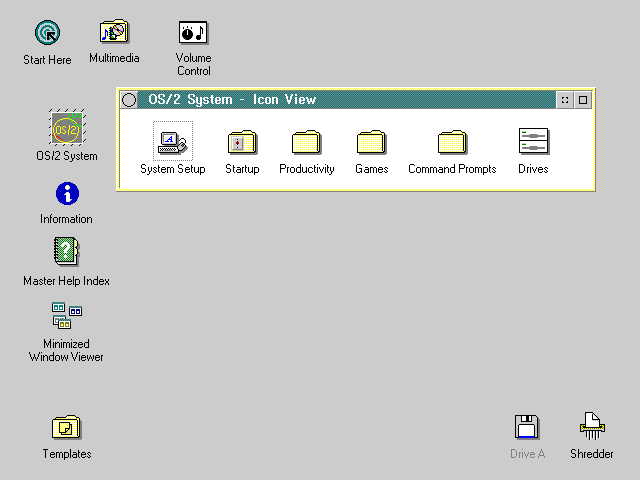
Yup, I had shiny new multimedia icons there. And of course, I had sound! OS/2 starting up, windows opening and closing, error windows popping up, everything had a sound bit associated. Remember, this was 1993! There was even software motion video included, although to be really able to use it I'd need to install video drivers supporting at least 256 colors (and I don't have any for my Matrox G400). At 16 colors, Ultimotion videos look just horrible and Indeo clips don't play at all. The 2.1 CD included the same sample videos included later on OS/2 Warp CDs.
There were few other not so visible enhancements in OS/2 2.1. It had
the new 32-bit Graphics Engine that didn't make it into OS/2 2.0. It included
APM support, primarily for laptop computers. And last but not least, version
2.1 offered wider selection of printer and display drivers.
The codename of OS/2 2.1 was Borg. This certainly fit OS/2 for
Windows well, given the situation on the market. Microsoft had OEMs under
tight control and prevented them from preloading anything other than MS-DOS/Windows.
This was later found illegal but that did not help OS/2 in any way. With
OS/2 for Windows, IBM found a way for OEMs to preload OS/2 while still
honoring their agreements with Microsoft. I remember that in 1993-94, several
major German retailers were offering OS/2 preloads.
Information about Borland C++ can be found on the OS/2 2.0 page and and I'm not that interested in networking. That leaves WordPerfect and Lotus. In 1993, WordPerfect Corp. released WordPerfect 5.2 for OS/2. Like many other ported applications, it used Micrografx Mirrors. It looked like this:
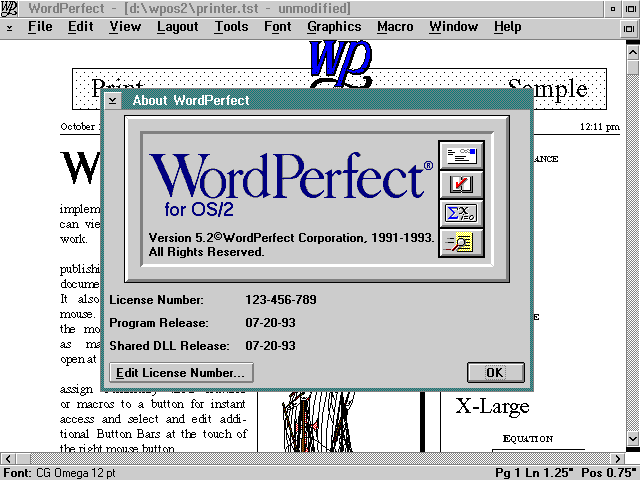
Unlike the immensely popular WordPerfect 5.1 for DOS, version 5.2 for OS/2 (and Windows too) was a WYSIWYG word processor. And it was a powerful word processor. It looked pretty much like every other word processor, but it had the wonderful "Reveal Codes" feature:
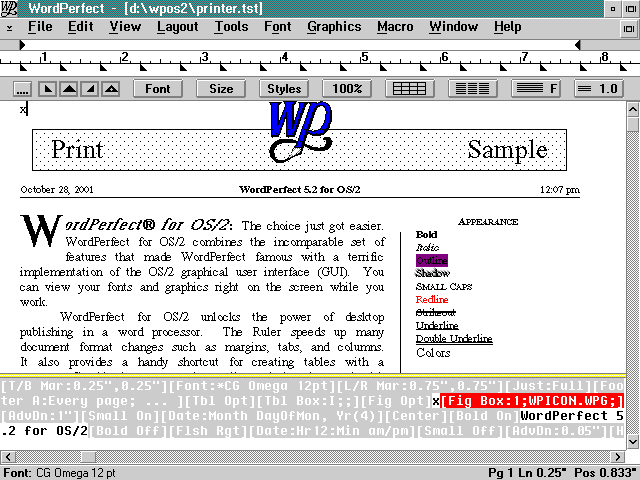
Last time I criticized Corel for doing a quick and dirty job with their CorelDraw 2.5 port. WordPerfect 5.2 for OS/2 was totally different and yet very much the same. It offered comprehensive WPS integration and was in fact a model WPS enabled application:
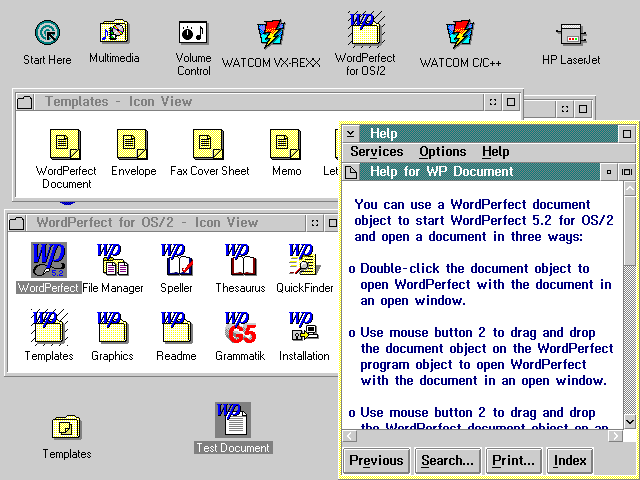
It had document templates, supported extensive drag and drop operations on WordPerfect documents (printing etc.) and all those goodies. Unfortunately, most WP 5.2 users complained that it was also very slow (I didn't notice that on my PIII-600 of course) and buggy. An interesting fact is that WP 5.2 was a 16-bit application and was in fact built with Microsoft C 6.0. I'm sure that made Microsoft very happy. It seems that most OS/2 WordPerfect users preferred (and still prefer!) DOS versions 5.1 or 6.x to this (sort of) native product. WordPerfect Corp. was working on an OS/2 version of WordPerfect 6 for OS/2 but canned the product in December 1993, probably because WP 5.2 for OS/2 was not received very well. Whether the fault was with WordPerfect or OS/2 users is anyone's guess.
Now let's take a look at WordPerfect's competitor from Lotus Development Corporation: AmiPro 3.0 for OS/2, released in 1993. AmiPro in my opinion was never as powerful as WordPerfect but it was OK for typical office use. AmiPro was also able to work together with other Lotus products like 1-2-3 or Notes.
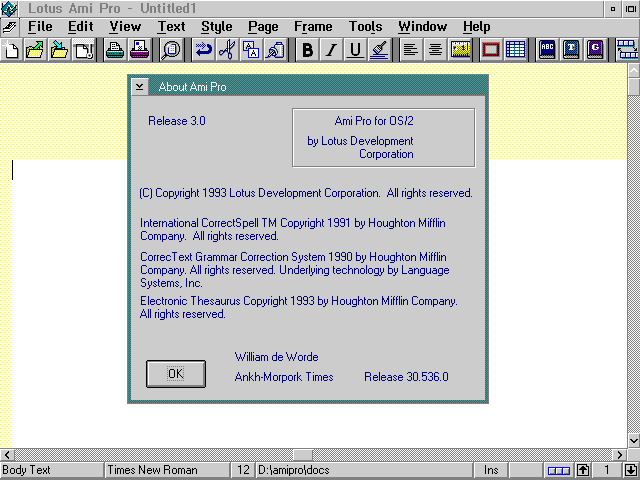
Just like WordPerfect 5.2, AmiPro 3.0 was port of a Windows product. But unlike WP 5.2, AmiPro did not use Mirrors and it was a purely 32-bit program (built with Borland C++ 1.0 for OS/2).
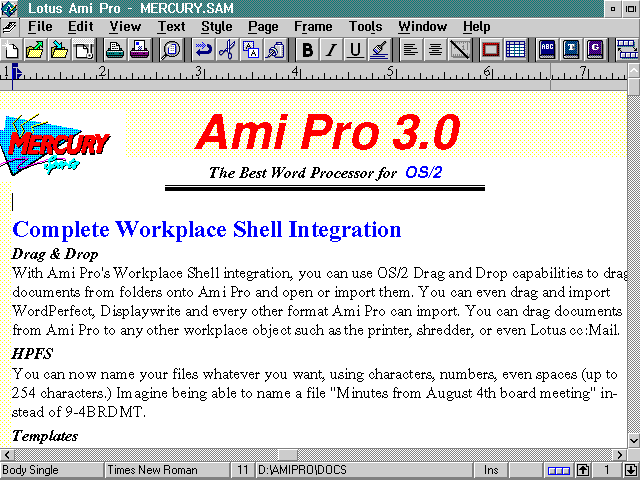
AmiPro 3.0 for OS/2 was missing some features of its Windows counterpart (drawing and charting) but on the other hand it had a few OS/2 specific features such as REXX integration. I am not sure if AmiPro 3.0 was Lotus's first OS/2 word processor, but I am certain it wasn't the last. There were several updates to AmiPro 3.0 (the latest was 3.0b I believe) and it was later followed by WordPro. I am not certain how good AmiPro 3.0 for OS/2 actually was but I have heard many criticisms regarding lack of stability.
The word processor preferred by many OS/2 users was DeScribe, developed by DeScribe, Inc. It was a native application developed for OS/2 from the beginning - I believe the first versions of DeScribe ran on OS/2 1.x. Just out of curiosity I looked at the program executable and determined that it was built with IBM CSet++ compiler. DeScribe was fast and powerful - it even offered some DTP-like features such as text frames and it included a drawing package:
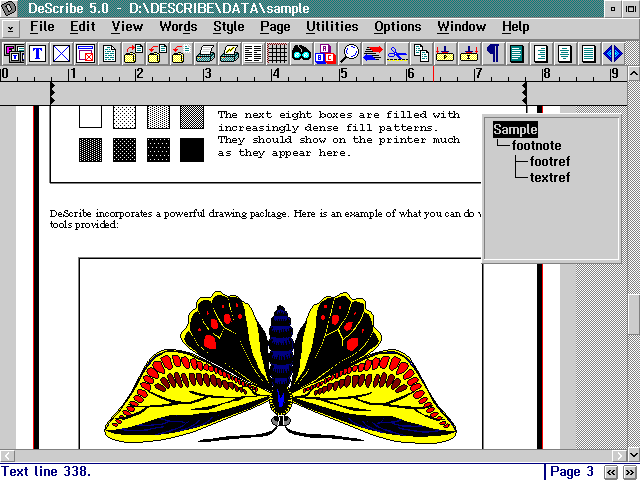
The above screenshot is from DeScribe version 5, released in late 1994.
It would be more appropriate to present a picture of DeScribe 4 or 3, but
version 5 is all I have. While many users of AmiPro 3.0 and WordPerfect
5.2 stopped using those products because of bugs and instability, DeScribe
users claimed that their word processor wouldn't buckle even under heavy
load.
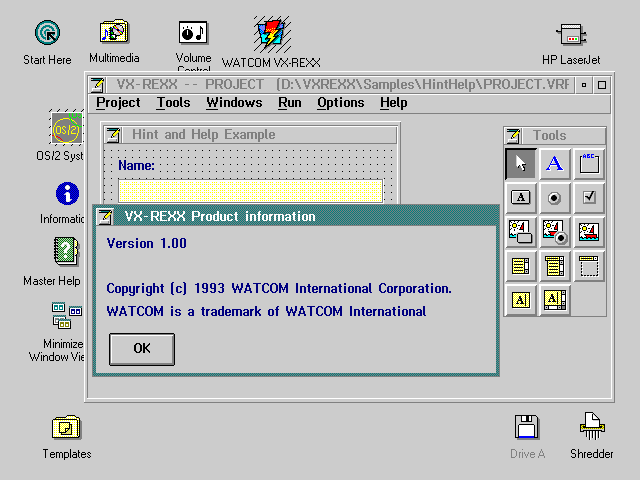
VX-REXX conceptually resembles products like Delphi or Visual Basic. The user creates windows and places GUI controls (objects) on them. Each object has an extensive set of properties, neatly presented in a notebook control. Objects can receive events and each event can be associated with REXX code. Simple yet powerful.

Watcom VX-REXX was (and still is) a popular tool thanks to its ease of use, power and flexibility. Creating simple GUI applets is very easy with VX-REXX and several nice sample programs were included.
I should probably mention that Watcom VX-REXX 1.0 came on a single 3.5"
HD floppy and had extensive online documentation (identical to the printed
manual). Products like that just don't seem to happen today. And VX-REXX
had competition too - VisPro REXX. I'm sure if I didn't mention VisPro
REXX, I'd get hate mail from its devotees<g>.

You can immediately see that it's not OS/2 2.1 - the color scheme makes a big difference. If you look closer, you will see that the desktop layout and all the icons are unchanged, but the color scheme is about the same used later in OS/2 Warp. And it looks way better. Technically, OS/2 2.11 SMP was an amazing beast. Its authors took OS/2 2.11 - which was not really designed with SMP in mind - did some magic to key components (primarily kernel, loader and DOSCALL1.DLL) and ended up with one of the best SMP operating systems. This is because SMP support in OS/2 was (and is) very fine-grained and not only can different processes run on different CPUs but threads within a single process can as well. Thus even applications not specifically designed for SMP can take advantage of it if they are multithreaded.
I nearly didn't get OS/2 2.11 SMP running in multiprocessor mode. On the only SMP machine I have access to, an IBM IntelliStation M Pro equipped with two 300 MHz Pentium II CPUs, it would just lock up early in the boot process. But that didn't surprise me too much because OS/2 2.11 SMP had a reputation for being very very picky about the hardware it would run on and this machine was made when 2.11 SMP was not supported anymore. But then I had the bright idea to use OS2APIC.PSD (the SMP Platform Specific Driver) from Warp Server for e-Business and to my surprise, it actually worked!
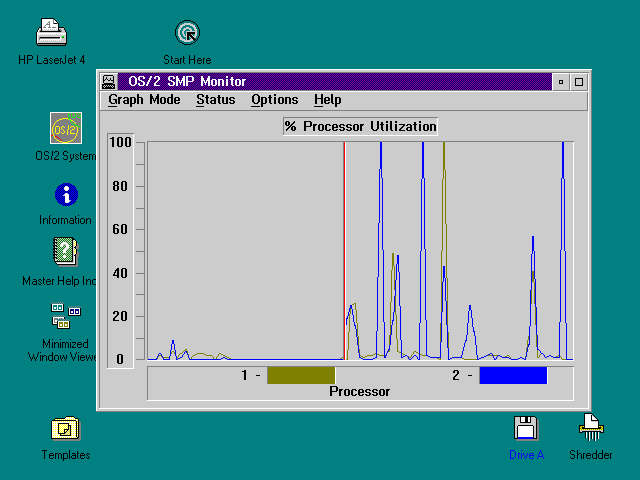
Above is a screenshot of the multiprocessor CPU monitor utility which
shows processor utilization as well as lets you selectively turn individual
CPUs on or off. It is one of the very few visible differences between SMP
and regular version of OS/2 2.11 so take a good look at it.
As usual, this was not without difficulties. Object Desktop doesn't really look very well in VGA resolution, making me search for some kind of SVGA solution for OS/2 2.11. The drivers for my Matrox G400 should have worked on OS/2 2.11. But didn't. Why wasn't I surprised? Fortunately I have access to what might be world's largest collection of graphics cards. After several more failed attempts I finally found an ancient S3 928 which worked with the drivers that came with OS/2. In the process I learned to appreciate the boot to command line feature - which was sadly not present in OS/2 2.11. I also got quite good at manually installing VGA drivers by editing CONFIG.SYS and OS2.INI. And here are the results of my hard work:

You can see the wonders of Object Desktop 1.0 - Enhanced Folders, Tab LaunchPad (there was no LaunchPad in OS/2 2.1 yet) and the Control Center with perhaps the single most valuable feature of Object Desktop: virtual desktops. Oh, and I mustn't forget the close button added to every window. But Object Desktop didn't stop there:
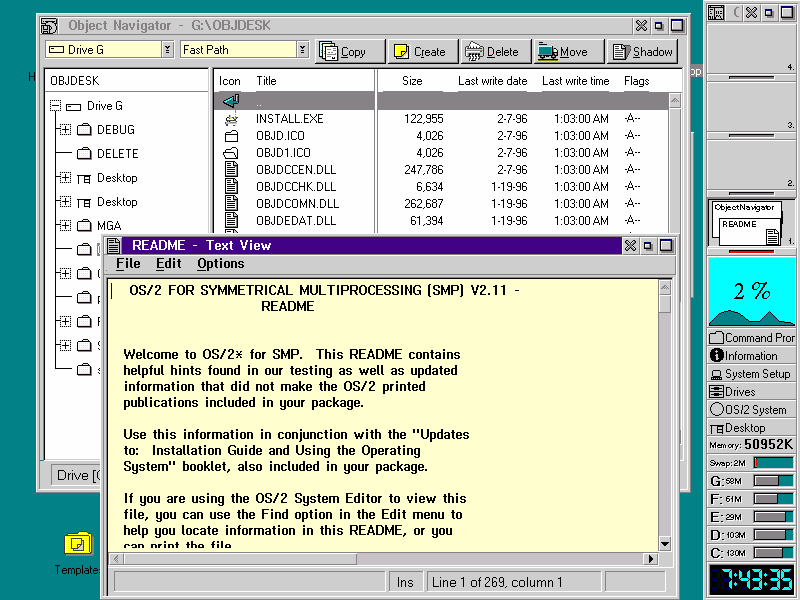
This is the Object Navigator and Enhanced Data Object with a nice little text viewer. And looking at the Control Center again, there are all the little monitors of CPU utilization, RAM, swap space and disk space (and a time monitor a.k.a. clock), plus shadows of the Desktop and important folders. Doesn't it just look cool? Object Desktop had many more features but I really don't have enough space to describe half of them. Installing Object Desktop was almost like upgrading to a new version of the OS.
Compared to OS/2 2.0, version 2.1 and 2.11 wasn't all that interesting.
There was a number of enhancements but most of them weren't very visible
(that didn't make them less important though). Nevertheless, OS/2 2.1 had
substantially wider selection of available applications and attracted a
number of new users frustrated by the inherent instability of Windows 3.1
and looking for something better than DOS. And perhaps most importantly,
OS/2 2.1 set stage for the version of OS/2: Warp. But OS/2 Warp
most certainly deserves its own page.
Thanks to Kris Kwilas for the copy of Object Desktop 1.0.